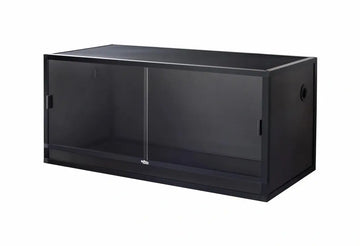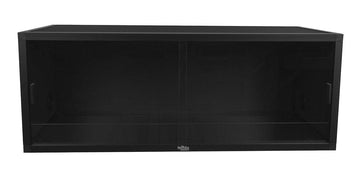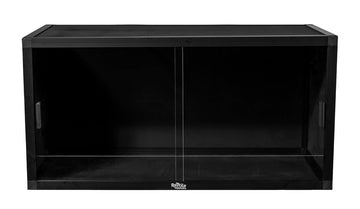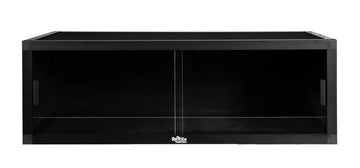The Asian leaf turtle (Cyclemys dentata) is a 6-9.5” long species of semi-aquatic reptile native to southeastern Asia. They can most often be found in moist forests with plenty of leaf litter and proximity to bodies of shallow freshwater such as streams, rivers, and ponds.
Asian leaf turtles have a boxy head with a tapered snout, gently domed shell with serrated posterior scutes, and webbed feet. Coloring and pattern vary by population. The shell is reddish to dark brown with matching skin, and there may be lighter striping on the head and neck. The plastron may be pale, yellow, or reddish, and may be patternless or feature darker radiating markings on each scute.
Asian leaf turtles are primarily available wild-caught, but they have been bred successfully in captivity. If you are considering this pet, expect something intermediate to advanced in difficulty, depending on your previous experience with turtles.
Minimum enclosure size for Asian leaf turtles
Due to the fact that they wander around on land as well as in the water, the minimum acceptable enclosure size for an Asian leaf turtle is 8.25’L x 4’W x 2.5’H, or 35 square feet of space. Juveniles under 6” long can be temporarily housed in something about half this size to get started. Larger is always better!
Due to this species’ humidity needs, an open-top indoor enclosure should not be used. Half of the setup should be water and half should be land. The water should be 2-4” deep for youngsters, but as they get older, the depth should be increased to 6-8”. The idea is that the turtle should be able to breathe easily even when standing on the bottom. For best results, offer areas of shallower and deeper water.
If possible, it’s best to house your Asian leaf turtle outdoors rather than indoors — even if it’s just for part of the year! If your local climate generally stays between 70-90°F during both day and night, then outdoor housing should be considered. Housing outdoors is convenient due to increased available space and “free” heat/UVB, but keep in mind that the enclosure must be secured against both predators and potential escape.
Cohabitation (housing multiple Asian leaf turtles in one enclosure) is not recommended for indoor enclosures. It may be considered for especially large outdoor enclosures.
Do Asian leaf turtles need UVB?
Yes, Asian leaf turtles require regular exposure to UVB light to maintain good health. The best UVB bulbs for this species are:
- Arcadia T5 HO 6%
- Zoo Med T5 HO Reptisun 5.0
Your UVB bulb should be half the length of the enclosure, mounted in a reflective Arcadia or Vivarium Electronics fixture, and placed 7-9” above the top of the turtle’s shell when basking. The fixture should be placed over the enclosure’s mesh top.
Lamps should be on for 12 hours/day, or programmed to sync with your local sunrise and sunset times. This is likely to boost your turtle’s long-term health by encouraging natural hormonal rhythms.
Artificial lighting of any kind is not necessary if the turtle is outdoors.
Best temperature for Asian leaf turtles
Like other reptiles, Asian leaf turtles are cold-blooded, which means that they rely on external temperatures to manage their own body temperature and metabolism. A reptile’s enclosure should offer a range of temperatures to allow them to thermoregulate effectively.
Specifically speaking, Asian leaf turtles should have a basking temperature around 90°F. On the other side of the enclosure, the temperature should be between 76-80°F. These temperatures should be measured with at least two digital probe thermometers. Heating should be turned off at night, but temperatures allowed to drop no lower than 70°F, preferably maintained between 75-80°F.
Provide heat for your turtle with a couple of 40-60w incandescent heat bulbs clustered in a dual lamp fixture. Do not use ceramic heat emitters (CHEs), red bulbs, or blue bulbs, as these are not as effective. Water temperature should be maintained within the same range as the ambient temperature, using a water heater if necessary.
If you need nighttime heating, don’t keep your heat lamps on. Instead, use a lightless heat source such as a radiant heat panel controlled via thermostat.
Asian leaf turtles housed outdoors in an appropriate climate should not need additional heating.
Best humidity levels for Asian leaf turtles
Asian leaf turtles need an average humidity of 80% during the day and higher at night in the land portion of their enclosure. There should also be humid hides available, lined with moistened sphagnum moss. Humidity should be measured via digital probe hygrometer, with the probe placed in the middle of the enclosure.
The large amount of water in the enclosure should go a long way toward helping maintain high humidity levels. However, you can increase humidity as needed by misting the substrate 1-2x/day with a pressure sprayer.
Outdoor enclosures don’t need too much in the way of humidity maintenance, but it’s beneficial to make sure that the substrate in the enclosure stays moist and that humid hiding places are kept available.
Water maintenance for Asian leaf turtles
Asian leaf turtles are semi-aquatic reptiles, so although they spend more time on land than most turtles, they still spend most of their time in the water. This means that you’ll be essentially maintaining a shallow pond with an accessible land area. The water must be kept as clean as possible to maintain your turtle’s health.
Both indoor and outdoor Asian leaf turtle enclosures require filtration and water changes!
Filtration
Even shallow bodies of water need filtration. It’s best to use a canister-style filter capable of handling at least slightly more than the amount of water in the enclosure. To calculate the amount of water in your leaf turtle’s swimming area, multiply the approximate length, width, and depth of the pond, and then convert the result into gallons. This is one aspect of your setup where it’s very important to invest in excellent equipment!
Water Changes
You will also need to perform routine water changes. Once every 1-2 weeks, remove and replace approximately 30% of the enclosure’s total water volume. As essential as filters are, periodically removing “old” water and replacing it with “new” water helps prevent toxic compounds from building up. To make water changes easier, use a siphon or water pump.
Juvenile enclosures with especially shallow water may not be able to be efficiently filtered. If this is the case for you, complete water changes accompanied by disinfectant application will need to be performed every week.
Best substrate for Asian leaf turtles
Providing a thick layer of naturalistic substrate (“bedding”) will help maintain correct humidity levels and also provide something for your turtle to burrow into as desired. We recommend the following substrates for Asian leaf turtles:
We also recommend providing a thick layer of leaf litter and sphagnum moss for enhanced humidity and enrichment value.
Substrate should be at least 2-4” deep and completely replaced every 3-4 months. Remove poop and urates daily, along with contaminated substrate.
How to decorate an Asian leaf turtle enclosure
An empty terrarium makes for a bored turtle, reducing its quality of life. Keep your pet entertained and engaged with its environment with the strategic use of décor items that encourage it to exercise natural behaviors!
Here are some ideas to get you started:
- additional hiding places/burrows
- driftwood
- hollow logs
- cork flats
- live or artificial plants
The more stuff you add, the more functional your enclosure is likely to become! Foliage and other forms of cover are especially important for this species, as they are forest-dwelling and generally prefer the shade.
What to feed to an Asian leaf turtle
Asian leaf turtles are omnivores, which means that they need a diet of both animal- and plant-based foods in order to get the right nutrition. For best health, juveniles should be fed every day to every other day, while adults should be fed 2-3x/week. Beware of excess weight gain!
Protein sources for Asian leaf turtles: dubias, discoids, earthworms, mealworms, snails, crickets, hornworms, silkworms, black soldier fly larvae, darkling beetles, shrimp, guppies, mollies, platies, mosquito fish
Fruits for Asian leaf turtles: figs, cherries, strawberries, raspberries, plums, watermelon, tomatoes, bananas
Food can be offered either on land or in water, chopped as needed.
Supplements
You will also need calcium and vitamin supplements to prevent your turtle from developing a potential deficiency. For calcium, we recommend keeping a cuttlebone in the enclosure for your turtle to gnaw on as needed.
For vitamins, we recommend using high-quality aquatic turtle pellets as part of your pet’s dietary rotation. Good formulas include Omega One Juvenile Turtle Pellets, Omega One Adult Turtle Sticks, Tetra ReptoMin, Zoo Med Natural Aquatic Turtle Food, and Mazuri Aquatic Turtle Diet.
How to handle your Asian leaf turtle
Asian leaf turtles, like most turtles, are not the kind of pet that can be handled regularly. It’s best to keep a hands-off approach with this species. If you want to interact with your pet, hand-feed them at mealtime with a pair of soft-tipped feeding tongs.
*This care sheet contains only very basic information. Although it’s a good introduction, please further your research with high-quality sources. The more you know, the better you will be able to care for your pet!
"Cyclemys dentata (Gray, 1831) Stream Terrapin" by LennyWorthington is licensed under CC BY-SA 2.0.











